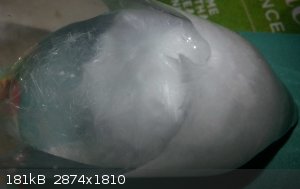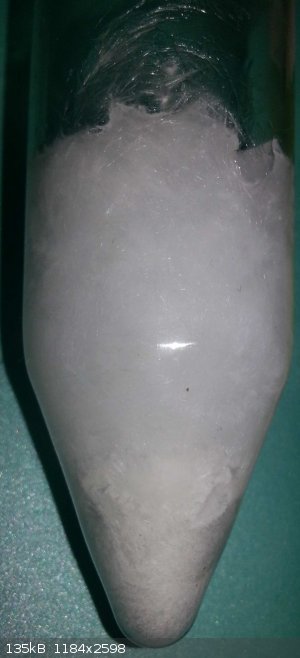RogueRose
International Hazard
    
Posts: 1593
Registered: 16-6-2014
Member Is Offline
|
|
Caffeine particles crashed out after saturation - 400mg filled 25ml H2O w/ crystals
I wanted to see how soluble anhydrous caffeine is in water so I tried adding about 100mg to ~25ml of water. The very fine particles dissolved quickly
leaving a few larger pieces (smaller than .5mm) in solution. I added another 200mg and it dissolved nicely as well. A final 100mg was added and
after a few minutes of shaking over 99% was dissolved.
I added another ~150mg and almost instantly the solution turned from clear to milky white. I allowed the newly added solids to settle to the bottom
and I then noticed about 2x the amount newly/final added solids settle out in an extremely fine powder and the solution remained very milky looking.
After about 30 mins, the solution is pretty opaque kind of like when you have a super saturated salt solution or another kind of saturated solution -
it seems to be refracting light much differently than normal solutions.
I was VERY surprised at the amount of caffeine that was able to dissolve as I had expected maybe 50mg or so to dissolve in that 25ml, maybe not even
that much.
I have two questions as to what probably happened. Could this have dissolved better b/c it was anydrous? IDK what they hydrate level are for the
compound. I'm guessing that somehow a super-saturated solution was created which I find very odd considering I used ~60F water and just shaking by
hand in a test tube.
I'm also trying to figure out how much crashed out vs how much remains in the solution.
It looks like what happened is pretty close, if not exactly, what is done in the micronization process for some pharmaceuticals which is pretty neat
that it can be done this easily. It can be further controlled by changing temp, pressure and solvent(s) which can be used to control the final
particle size.
https://en.wikipedia.org/wiki/Micronization
So, this was a neat learning experience that I didn't expect to come out of some messing around. The solution now looks the same and I remember what
it looks like, when oil and water mix, sometimes with a surfactant or emulsifier, it gives a hazy looking liquid. It seems that some of the ultra
small particles remain in suspension after much of the rest has fallen out (at about 50 mins from crashing out of solution).
edit - I looked at the vial after about 4 hours and the entire volume of water has turned to crystals with maybe 2-3ml of clear solution on the top.
It created very beautiful long very fine needle like crystals and all of this from about 550mg of anhydrous caffeine (with about 150mg completely
undissolved and another maybe 100-200mg that crashed out as a powder). The crystals formed in what was the cloudy white solution after the particles
crashed out and settled. All this was done at room temp of about 68F.
This really is amazing that it formed that much crystals from such a small amount of caffeine.
[Edited on 12-16-2018 by RogueRose]


[Edited on 12-16-2018 by RogueRose]
[Edited on 12-16-2018 by RogueRose]
[Edited on 12-16-2018 by RogueRose]
|
|
|
Tsjerk
International Hazard
    
Posts: 3032
Registered: 20-4-2005
Location: Netherlands
Member Is Offline
Mood: Mood
|
|
Maybe, just guessing, you have either a salt of caffeine, or a salt formed with moisture and CO2 from the air over time in storage?
|
|
|
RogueRose
International Hazard
    
Posts: 1593
Registered: 16-6-2014
Member Is Offline
|
|
Quote: Originally posted by Tsjerk  | | Maybe, just guessing, you have either a salt of caffeine, or a salt formed with moisture and CO2 from the air over time in storage?
|
I really doubt that it is a salt. I was looking at it again, the anhydrous, and it is the same as when I got it. I'm thinking about trying the
experiment again and this time weighing out everything in mg's and take a more accurate reading on the water used.
I just can't get over the amount of crystals that formed from this. From what I've found, there is only one hydrate which is the monohydrate.
The anhydrous powder is stored in the same HDPE bottle that I keep many other chemicals in and I still have some NaOH I got at the same time as the
caffeine (in the same bottle type) that is still dry and it has been opened about 20x more than the caffeine which has only been opened about 5-6x
since I got it.
I don't think caffeine absorbs CO2 or moisture very readily. Wiki states that solubility is 2g/100ml at room temp which is about what I estimated
from my experiment, but IDK how it formed the amount of crystals it did.
I guess I'll remove the crystals, filter off the H2O and weigh them then dry them and see what I get - then repeat the whole thing and see what
happens again.
The only thing that is an unknown is that I used tap water b/c I wasn't planning on using any of the material again and I figured it was fine to
estimate a rough solubility estimate.
Any suggestions on how to analyse or things you would do?
|
|
|
fusso
International Hazard
    
Posts: 1922
Registered: 23-6-2017
Location: 4 ∥ universes ahead of you
Member Is Offline
|
|
Quote: Originally posted by Tsjerk  | | Maybe, just guessing, you have either a salt of caffeine, or a salt formed with moisture and CO2 from the air over time in storage?
|
Caffeine can form salts?
|
|
|
DavidJR
National Hazard
   
Posts: 908
Registered: 1-1-2018
Location: Scotland
Member Is Offline
Mood: Tired
|
|
Yes. It's weakly basic.
|
|
|
Sulaiman
International Hazard
    
Posts: 3695
Registered: 8-2-2015
Location: 3rd rock from the sun
Member Is Offline
|
|
Caffeine solubility approximately doubles foe each 10oC temperature rise, which is clearly an important consideration.
http://www.amazing-food.com/caffeine-solubility-content-coff...
I'd expect the dry crystals to be much less voluminous.
CAUTION : Hobby Chemist, not Professional or even Amateur
|
|
|
Tsjerk
International Hazard
    
Posts: 3032
Registered: 20-4-2005
Location: Netherlands
Member Is Offline
Mood: Mood
|
|
I have seen organic compounds crystallizing in very voluminous ways from water. And the other way around, where water crystallized from solvent were
only a small percentage of water filled the whole volume of solvent with crystals.
|
|
|
RogueRose
International Hazard
    
Posts: 1593
Registered: 16-6-2014
Member Is Offline
|
|
It does mix with citric acid to form caffeine citrate, I'm aware of that.
|
|
|
Nakhimov
Harmless

Posts: 16
Registered: 8-12-2018
Member Is Offline
|
|
Did the solvent cool over time? From the reaction method you described, it's likely you basically just performed a recrystallization of the caffeine.
You could do a vacuum or gravity filtration and then a gravimetric analysis on the filtrate to get a better idea of the solubility of the caffeine in
water at room temperature. (I'm seeing values of 16mg/mL at RT and 200mg/mL at 80°C, so I think the results you saw aren't too terribly unusual.)
edit: Just wanted to add, those are lovely crystals! They would have had to have formed slowly to get such a nice shape, so keep that in mind.
[Edited on 12-18-2018 by Nakhimov]
|
|
|